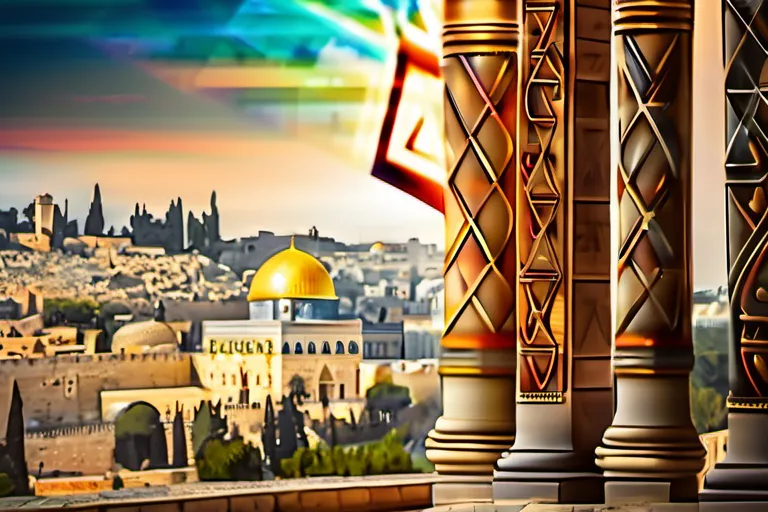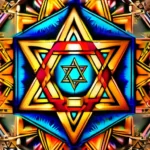Exploring the history, symbolism, and significance of the Star of David
The Star of David, also known as the Shield of David or Magen David, is a hexagram that has been used as a symbol by Jews for centuries. In this article, we will delve into the origins, history, and meanings associated with this powerful symbol.
The Origins and History of the Star of David
The Star of David, known formally as Ma’atenu, has captivated imaginations for centuries. But have you ever wondered about its true origins? Was it always a symbol associated with Judaism and the Jewish people? To answer this question, we need to look back into history.
The earliest known mention of what might resemble a hexagram can be found in biblical times, though there’s some debate among historians. Some scholars suggest that the hexagram as a symbol was used much earlier, possibly even by ancient Mesopotamian civilizations for various purposes like architectural decoration or astrological signs.
However, when we think of the Star of David in its current form, it’s hard to ignore the significant evolution that took place over time. It wasn’t until the medieval period that this symbol started to gain prominence within Jewish communities. But why did it suddenly become so important? Some argue it was due to numerological significance, as the number six (the two triangles) represents earthly or physical existence, while three (the apex of each triangle) represents spiritual or divine presence.
The star’s journey through history is like a winding river that twists and turns. By the late Middle Ages, it became a popular motif in Jewish art and architecture. Yet, its modern recognition as a symbol of Judaism came much later during the Zionist movement at the turn of the 20th century. Theodor Herzl, the father of modern political Zionism, is often credited with proposing this symbol for the flag of Israel.
But what truly makes the Star of David such an enduring symbol? It’s not just its shape; it’s the stories and meanings we’ve attached to it over millennia. Each point of that hexagram seems to whisper tales of survival, unity, and hope in a world often fraught with challenges. As historian Shlomo Sand once noted, ‘The Star of David is like a prism through which light can be refracted into many colors.’
So as we delve deeper into the symbolism of this star, remember that every piece of its history adds another layer to its meaning. The more we explore, the richer our understanding becomes.
The Symbolism of the Star of David
The Star of David, also known as the Mogen David ( Shield of David ), is more than just a symbol; it’s a profound metaphor for unity and protection. Imagine, if you will, a six-pointed star that seems to dance between two triangles, one pointing up and the other down. What does this star mean? Is it merely an emblem or does it hold deeper spiritual significance?
Unity is at the heart of its symbolism. Picture a tree with strong roots and sturdy branches reaching out in all directions. Just as the tree supports itself through its interconnected parts, so too do we find strength in unity within communities and families. The Star of David represents this interconnection, where each point touches another, forming a unified whole.
Protection is another layer to its meaning. Think of a fortress with its mighty walls and strategic towers. Each corner and bastion works together to safeguard the city. In a similar way, the Star of David acts as a protective shield for those who wear it or embrace its symbolism. It serves as a reminder that we are not alone; we have each other’s backs.
For many, the Star of David is more than just a decorative element—it’s a beacon of identity and heritage. Imagine wandering through an old synagogue, seeing the Star of David emblazoned on walls and artifacts. It feels like stepping into history, where the past meets the present in a powerful embrace.
So, what does the Star of David mean to you? Is it a symbol of hope, protection, or unity? As we delve deeper into its meaning, remember that symbols often hold many layers of interpretation, much like a rich tapestry. Each thread represents a different perspective, weaving together to form a beautiful whole.
The Star of David in Jewish Culture
The Star of David, also known as Magen David or Shield of David, is a powerful symbol that has been deeply intertwined with Jewish culture for centuries. But have you ever wondered how this six-pointed star found its way into the heart of Jewish traditions? Could it be just a decorative element, or does it hold more profound significance?
Imagine walking through an old synagogue and seeing intricate designs on the ceiling that resemble the Star of David—these aren’t mere ornaments. They serve as a testament to the rich history and spiritual depth of this symbol. In Jewish culture, the Star of David is not just a simple star; it’s a representation of unity and strength.
Consider for a moment how the Star of David is often depicted in religious art and architecture. It appears on synagogues, ceremonial objects, and even on some pieces of jewelry worn by Jews around the world. Each time you see this symbol, whether at home or abroad, it’s a reminder of the enduring connection to Jewish heritage.
But why does the Star of David hold such importance? Some argue that its origins can be traced back to the 14th century, when it was used on the coat of arms of the House of David. Others believe it has been around even longer, symbolizing the protection and shield of God for the Jewish people. Regardless of its historical roots, one thing is certain: the Star of David is a powerful emblem that transcends time and place.
As you explore the symbolism behind the Star of David, think about how it represents the unity of the Jewish community. Just as the six points come together to form a complete star, so too do the diverse branches of Judaism unite under this common symbol. It’s more than just a visual representation; it’s a powerful statement of identity and solidarity.
The Star of David is not just a decorative motif; it’s a living testament to the resilience and continuity of Jewish culture. As you delve deeper into its history and significance, consider how this simple yet complex symbol has become an integral part of Jewish life, reminding us of our shared past and our collective future.
The Controversies Surrounding the Star of David
The Star of David, that familiar six-pointed star, has become one of the most recognizable symbols associated with Jewish culture and identity. But its journey from a lesser-known symbol to a widely recognized emblem is filled with controversy and complexity. How did this ancient geometric shape come to represent such profound meanings in contemporary times?
One of the earliest controversies surrounds its actual origins. Some argue that the Star of David has been around since biblical times, used by Solomon’s Temple. Others claim it was only widely adopted as a symbol during the 16th century in Poland and Germany. Regardless of its true origins, one thing is clear: its adoption and subsequent politicization have had far-reaching effects.
As the Star of David began to gain prominence, it faced challenges from non-Jewish groups seeking to co-opt this potent symbol for their own purposes. In the early 20th century, Nazi Germany used the Star of David in a sinister manner, forcing Jewish people to wear it as a badge of humiliation and oppression. This tragic twist in history has cast a long shadow over its use and significance.
Yet, the Star of David also became a beacon of resistance during the Holocaust. Jews used the symbol to secretly communicate with one another, hiding it within everyday objects like shoes or toys. It served as a powerful reminder of their shared identity and resilience in the face of adversity.
In recent decades, the Star of David has continued to be politicized, becoming a central figure in discussions around Israeli-Palestinian relations and Jewish statehood. Its use by various political entities has sparked debates about its role beyond religious or cultural contexts. Is it merely a symbol of heritage, or does it carry deeper political implications?
These controversies highlight the multifaceted nature of the Star of David. It is both a source of pride and a point of contention, reflecting the complex historical and cultural landscape of Jewish life. As we navigate its use today, we must grapple with these controversies and understand how they shape our perception and interpretation of this enduring symbol.
How can such a simple geometric figure hold so much meaning and provoke such diverse reactions? The Star of David is more than just a shape; it’s a lens through which we view the rich tapestry of Jewish history and identity.
The Modern Significance of the Star of David
The Star of David, often referred to as Magen David, has become synonymous with Jewish identity and culture. But what does it really mean in modern times? Is it just a decorative motif or does it carry deeper significance?
One might wonder if the Star of David is merely a symbol that people wear without truly understanding its historical roots. Could it be more than just a simple hexagram? The answer lies in how this shape has evolved to represent unity and resilience.
In contemporary Jewish life, the Star of David serves as a powerful emblem of identity. Jews around the world use it not only on religious artifacts but also on personal jewelry like necklaces and earrings. This ubiquitous presence suggests that the symbol resonates deeply with people’s sense of belonging and heritage. Can you imagine walking through a crowded marketplace and seeing so many people wearing something that signifies their shared history?
Moreover, the Star of David is not just worn; it’s also prominently featured on flags, buildings, and public spaces in Israel. This widespread use underscores its role as a unifying symbol for Jews across different regions and denominations. How can you overlook such a pervasive presence without questioning its importance?
The modern significance of the Star of David extends beyond mere aesthetics. It stands as a reminder of the struggles and triumphs of the Jewish people, encapsulating their perseverance in the face of adversity. Just like a beacon guiding lost souls back to home, the Star of David serves as a source of strength and solidarity for many.
Can you think about how this symbol might feel when worn by someone who has experienced diaspora or persecution? It could be seen as a protective talisman, warding off harm and bringing comfort. Is it any wonder that so many cherish this emblem?
The Star of David’s journey from a historical motif to a global icon is a testament to its enduring relevance. In an era where diversity and unity are often at odds, this symbol continues to bridge gaps and foster connections among people of Jewish heritage and beyond.
FAQs: Answering Common Questions About the Star of David
The Star of David, also known as the Mogen David or Shield of David, is one of the most recognizable symbols in Jewish culture. But have you ever wondered what exactly it looks like? It’s a hexagram, a six-pointed star, often depicted within a triangle. Is this shape just a geometric wonder, or does it hold deeper significance?
The origins of the Star of David are somewhat mysterious and span across centuries. Some believe its roots lie in ancient Jewish traditions, while others point to influences from other cultures such as the Solomon’s Seal motif found in medieval manuscripts. What makes this symbol so unique is its journey through history.
It wasn’t until the early 20th century that the Star of David became widely recognized and adopted by Jews around the world. In fact, it was first prominently used on the flag of the State of Israel in 1948. Why this particular symbol out of all others?
The answer lies in its dual representation as both a shield and a star. Just like a guardian providing protection or a guiding light leading us through life’s challenges, the Star of David embodies these qualities. For many Jews, it serves as a reminder of their resilience and continuity despite facing countless adversities over millennia.
But what about those who see the Star of David simply as a decorative element? Can such an interpretation be too superficial? While its aesthetic appeal is undeniable, it’s crucial to recognize that symbols like this one carry profound meaning. They are not just designs; they are carriers of history and emotion.
In essence, the Star of David stands as a powerful symbol of Jewish identity and continuity. Its journey from ancient traditions to modern-day politics reflects the complex interplay between heritage, culture, and national identity. Is there a more fitting representation for the enduring spirit of the Jewish people?
Conclusion
 The Star of David remains an important symbol for Jews around the world, representing unity, protection, and hope. Understanding its rich history and symbolism can provide valuable insights into Jewish culture and identity.
The Star of David remains an important symbol for Jews around the world, representing unity, protection, and hope. Understanding its rich history and symbolism can provide valuable insights into Jewish culture and identity.











